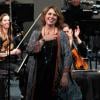
L’amour was in the air at the Alex Theatre in Glendale on Saturday, Feb. 15, as Los Angeles Chamber Orchestra presented a sweetly scented Valentine’s Day bouquet of French music, brought off with grace and élan by high-flying guest conductor Matthias Pintscher.
The musicians of LACO clearly enjoyed playing with Pintscher — the recently appointed music director of the Kansas City Symphony and a familiar presence on the podiums of many of the world’s great concert halls — responding with a beautifully detailed, lithe, and atmospheric performance that elicited frequent applause from the sizable audience.
Vraiment, the program’s title of “Impressionists” was a bit of a stretch. Hector Berlioz died in 1869, five years before the term “impressionism” first appeared in a review of Claude Monet’s painting Impression, Sunrise. Berlioz’s song cycle Les nuits d’été (Summer nights) was composed even earlier, in 1841, and orchestrated in 1856. Maurice Ravel disliked being called an impressionist, and his 1919 neoclassical Le Tombeau de Couperin (The tomb of Couperin), a tribute to friends lost during World War I, looks backward, not forward, also paying tribute to Baroque composer François Couperin. Gabriel Fauré’s pleasantly antic Masques et bergamasques, also from 1919 and inspired by commedia dell’arte characters, similarly plays with classical models. A friend of the composer’s described the style as “Mozart imitating Fauré.”

Of the four composers on the program, only Claude Debussy could be truly classified as an impressionist. A superbly nuanced, subtle, and languid performance of his groundbreaking modernist manifesto Prélude à l’après-midi d’un faune (Prelude to the afternoon of a faun), a fluid reimagining of Stéphane Mallarmé’s 1876 poem, opened the concert. Debussy called his score “a series of backdrops” for the “desires and dreams” of the faun, a horny creature from Greek mythology.
LACO’s principal flute, Benjamin Smolen, captured the spirit from the outset with his brilliantly sensual solo, tracing the dissonant tritone scale that announced a new era in musical history. So enchanting was Smolen’s playing that he nearly transformed the piece into a mini-concerto for flute. Throughout the evening, in fact, the impeccable and poetic solo work from him and his woodwind colleagues, prominently featured in all four pieces on the program, seemed to inspire the entire ensemble.
Veteran mezzo-soprano Michelle DeYoung brought a high level of professionalism and intensity to her performance of Berlioz’s demanding Les nuits d’été, which sets texts by French poet Théophile Gautier. Berlioz’s orchestrated versions of these six songs originally for voice and piano have been performed by sopranos, mezzos, contraltos, and even tenors. With lush, flowing melodic lines accompanied by restless, surging, lyrical orchestral accompaniment, the half-hour cycle requires stamina and interpretative variety from the soloist.

DeYoung for the most part rose to the occasion, but her heavy vibrato, covered tone quality, and occasionally choppy phrasing muted the emotional impact of the songs, which remain within a narrow range of lyrical expression. It did not help that it was impossible to read the program’s text in the darkness and that the projected English supertitles audiences have come to expect were not provided.
Masques et bergamasques and Le Tombeau de Couperin, both dance suites, proved to be congenial and scintillating hosts for the concert’s second half. Here, Pintscher and his band reveled in the frothy gaiety of Monte Carlo and Paris and the rustic charm of the French and Italian countryside. Pintscher took the Forlane from Tombeau, with its cascading dissonant chords, at a brisk tempo, finding the perfect combination of old and new, sweet and sour.
LACO’s very talented roster of soloists all made elegant contributions: Besides Smolen, oboist Claire Brazeau, concertmaster Margaret Batjer, clarinetist Joshua Ranz, hornist Michael Thornton, and harpist JoAnn Turovsky all deserve mention. In both the Fauré and the Ravel, Pintscher created a sparkling palette of colors and dynamics, guiding the orchestra in a collaborative fashion. Together, they found the music’s essential joie de vivre, emphasizing the refined contrasts at the heart of this seductive Gallic neoclassicism.




